Westringia ( Coastal Rosemary ) is an Australian Native plant suited to any type of garden. It is tough, hardy, drought tolerant once established, stands up to wind and salt spray, and still comes through smiling and flowering like a champion in a Miss Universe contest. These plants are used a lot around Sydney Harbour for the reasons described above, but they still benefit and look better from regular water, a little fertilizer, and a good trim every so often to keep the plant more compact. There are several varieties of Westringia, but the common ones grow to around 1.5 to 2 metres tall. The flowers are usually in shades of white or blue, and are very attractive, and adorn the plants year round., and the bees and butterflies love them. Plant them in a Sunny position for best results. These plants were growing around the Harbour foreshore.
Note - this plant is not Rosemary ( the culinary herb ), this is only the common name. To comment on the correct plant, always search for the plant using the Botanical name - Westringia .
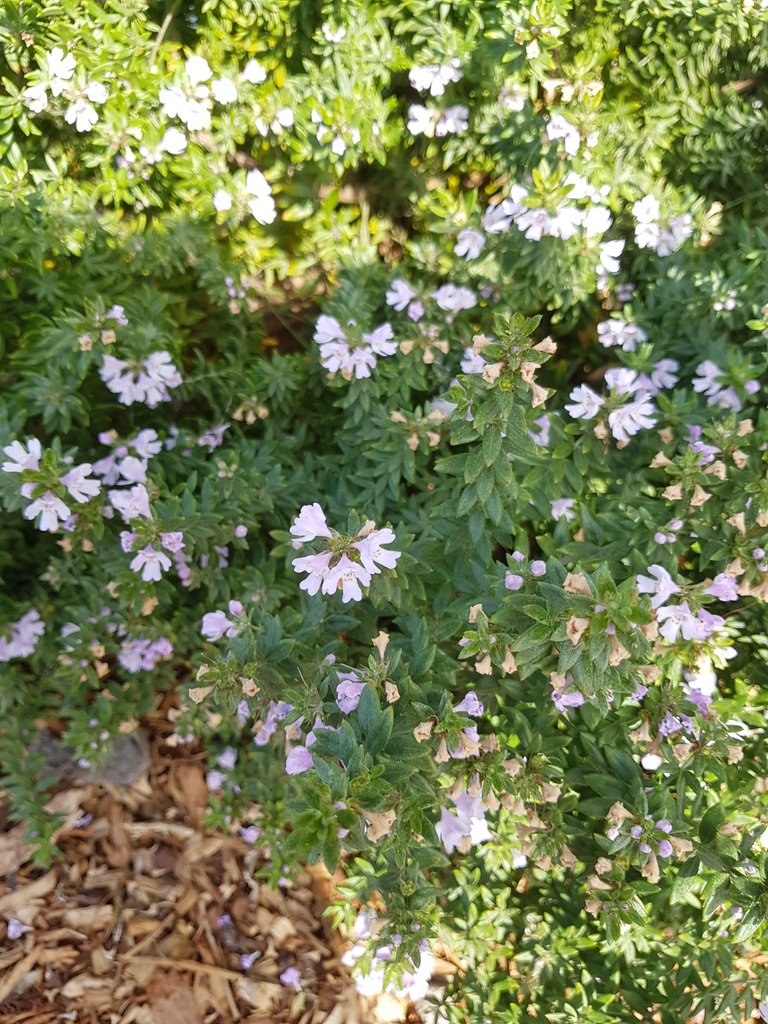
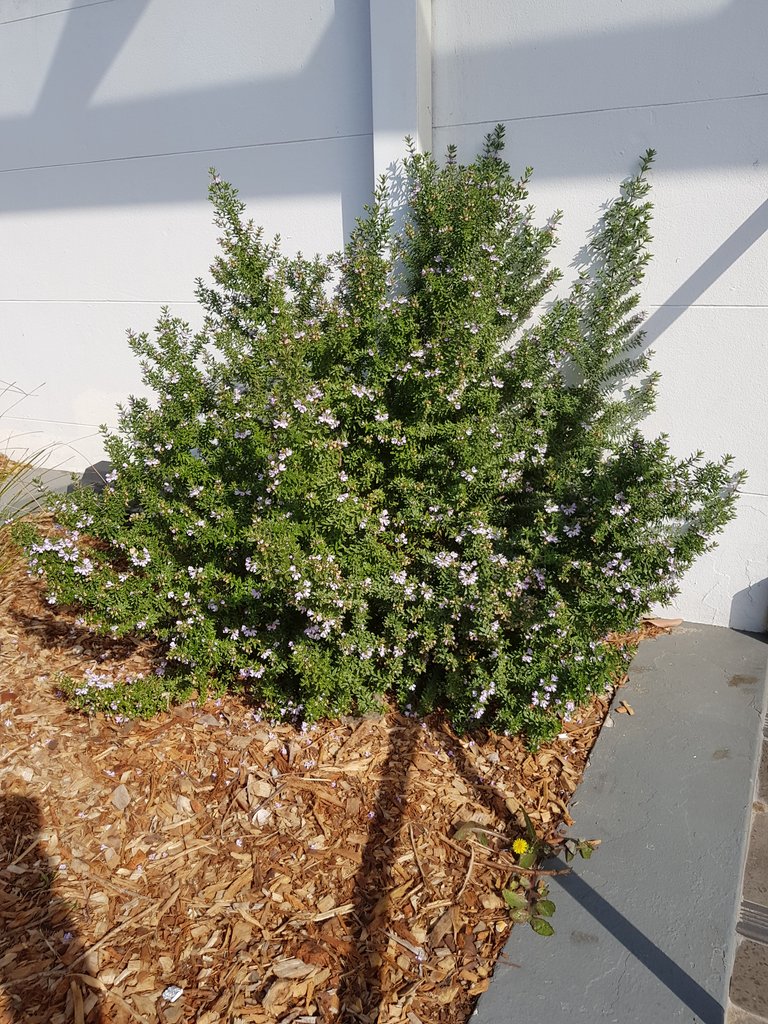
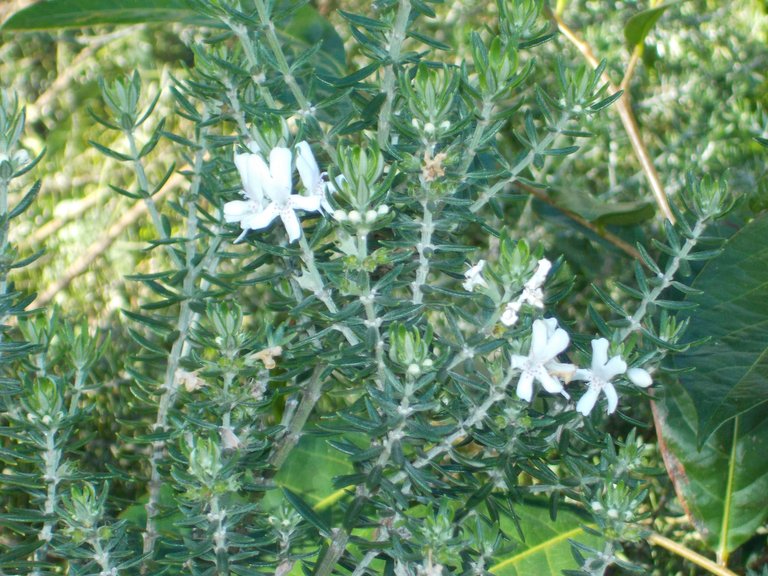
Coast rosemary naturally occurs in southeast Australia where it is native to sand dunes and coastal bluffs in both sandy and alkaline soils, and where it endures daily wind and salt spray. It is a fine textured evergreen shrub mounding 5-6 ft. tall, capable of spreading 5-8 ft. wide.
Small rosemary-like leaves grow to 1/2 in. long, are pale green above, white below and occur in whorls on whitish stems. Small white flowers occur at the tips of branches where they provide modest accent character during spring and intermittently throughout warm periods of the year.
The Coast rosemary is a fast growing species that is valued in Inland Empire landscape and gardens as a foliage plant that is attractive when clipped or unclipped. Plant in sunny locations, in well-drained soils and reduce watering during the summer. It is a reliable shrub with few pests or problems, and tolerant of temperatures to 10-15°F.
Cultivars include: Westringia 'Morning Light' has yellow-green foliage with white margins and white flowers, grows 3 ft. tall, 4-6 ft. wide,
and Westringia 'Smokey' grows to 5-6 ft. tall and as wide with pale gray foliage and white flowers.
Resources
Fav. comment Award !! Great Pics and information, thanks.
Thank you @ctrl-alt-nwo!
Have a great day!
A tough, small growing Australian native shrub with a compact, dense growth habit, introduced as an alternative to English and Japanese Buxus. Leaves are attractive, small, pale green maturing to emerald green, growing in whorls around the stems.
Pretty, pale mauve flowers appear during Spring and Autumn. Grows in full sun to part shade, developing a tighter habit in full sun. Tolerates a wide range of soils and conditions, growing in sandy loams to clay loams.
Withstands drought once established as well as heat, humidity, frost and salt spray. Best suited to arid Mediterranean climates. Clip every 12-18 months to form a tight hedge or leave to grow naturally to form a neat, ball-shaped plant.
Perfect in low maintenance mass plantings, borders/hedges, coastal sites and water-wise gardens.
Source
Westringia is a genus in the Mint Family with about 3 species, all endemic to Australia. Together with the closely related Prostanthera they are often called the Mint Bushes and many are used as ornamental plants in the garden. Westringia, which can be differentiated from Prostanthera by its leaves arranged in whorls and calyces with 5 distinct lobes while Prostanthera has a caylx with 2 lobes and leaves that are opposite. Westringia has a natural distribution throughout each state in Australia except the Northern Territories. They are generally tough plants and useful as large scale tall groundcovers, specimen plantings or for formal or informal screens. They have attractive whorls of small leaves that are usually a light gray-green color with some cultivars being attractively variegated. The flowers, which usually are most profuse from late winter to early summer color from white to light lavender though some can bloom year round in coastal climates. They grow best in full sun but some can tolerate a varying amount of shade and while fairly drought tolerant most of the cultivated forms come from the more mesic climates of eastern and south eastern Australia and appreciate irrigation in summer.
Small-leafed Westringia - An upright growing dense shrub 5-6 ft tall by 2-3 feet wide with gray-green 3/4 inch long narrow leaves whorled in sets of fours around slightly hairy branches. The large wide open flowers are a very pale violet to white. Very tolerant of diverse conditions from sandy to clay soils, wet or dry in sun or shade. This plant grew originally where the city of Hobart, Australia now stands
https://www.smgrowers.com/info/westringia.asp
All of these Westringias are bread in Australia from originally native plants and are tough, drought resistant and tolerant of cold conditions. They will grow in light shade to full sun, coastal positions and in virtually any reasonably well drained soil. Requiring virtually no care requirements, they have the added bonus of flowering against their appealing foliage. A little trimming to shape is recommended, although even left alone they remain compact and true to shape. Feed with a good quality slow release fertiliser in spring. These plants are a great alternative to Buxus and many other choices, establishing quickly and suffering virtually no disease or problems often associated with difficult locations.
Source: https://www.palmers.co.nz/westringia-the-perfect-hedge/
Westringia 'Edna'
Source
Plants of the Westringia variety are another highly versatile Australian native that suits a wide variety of uses ranging from expansive groundcover, to colourful formal hedges, box gardens, retaining walls or as an ornamental shrub.
Westringia will retain a healthy bushy appearance for many years without developing the woody appearance that spoils some groundcover plants.
Westringia fruticosa 'Naringa'
Source
The westringia varieties feature dense, fast-growing foliage with delicate mauve, blue-purple or white flowers with contrasting red or brown spots near the throat of each flower. The grey to deep green leaves form attractive whorls around the stem.
Westringia usually flower prolifically, often throughout the year, and also respond well to pruning.
Westringia 'Wynayabbie Gem'
Source
The popular Westringia owes its common names, ‘native rosemary’ or ‘coastal rosemary’, more to the shape of its leaves than any distinctive aroma. The leaves are often covered with an attractive contrasting grey or white velvety sheen.
Westringias are part of the mint family (Lamiaceae) but neither the leaves nor the flowers have a strong aroma.
Westringia 'Fructicosa'
Source
The name westringia is a reference to the 19th century Swedish lichen authority and royal physician, Johan Peter Westring.
Text Source
All of these Westringias are bread in Australia from originally native plants and are tough, drought resistant and tolerant of cold conditions. They will grow in light shade to full sun, coastal positions and in virtually any reasonably well drained soil. Requiring virtually no care requirements, they have the added bonus of flowering against their appealing foliage. A little trimming to shape is recommended, although even left alone they remain compact and true to shape. Feed with a good quality slow release fertiliser in spring. These plants are a great alternative to Buxus and many other choices, establishing quickly and suffering virtually no disease or problems often associated with difficult locations.
https://www.palmers.co.nz/westringia-the-perfect-hedge/
These Westringias are bread in Australia from initially local plants and are intense, dry spell safe and tolerant of cool conditions. They will develop in light shade to full sun, seaside positions and in for all intents and purposes any sensibly all around depleted soil.
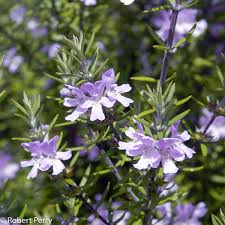
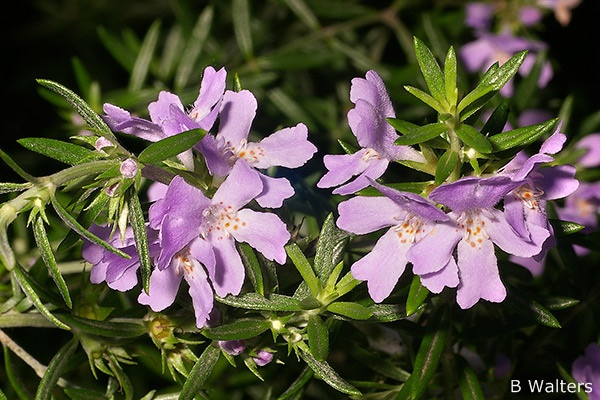
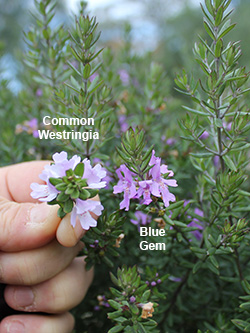
Requiring for all intents and purposes no care necessities, they have the special reward of blossomingagainst their engaging foliage. A bit of trimming to shape is suggested, albeit even taken off alone they stay smaller and consistent with shape. Feed with a decent quality moderate discharge manure in spring.
These plants are an awesome contrasting option to Buxus and numerous different decisions, building up rapidly and enduring practically no malady or issues frequently connected with troublesome areas.
References12 34
Thank you for posting @ctrl-alt-nwo.
Appreciate learning the botanical name.....'Westringia'.
Lovely photographs of this lovely plant in it's flowering season.
All the best to you.
Cheers!
Westringia fruticosa (Coast Rosemary) - This dense evergreen shrub that in cultivation here in California typically grows to be a 4-6 feet tall mound by nearly twice as wide and can be left as a dense rounded shrub or be sheared for a more formal look. The linear dark gray-green leaves look similar to rosemary foliage, explaining the common name and one of the synonyms for this plant, Westringia rosmariniformis. The small white flowers bloom along the branches year-round in mild climates but it is a spring-bloomer in colder areas. Plant in full sun where it is drought tolerant but keeps better color and remains more dense when given occasional spring and summer irrigation. Cold hardy to about 20° F. It is an excellent dense growing shrub for coastal plantings where it can tolerate wind and sea spray. It is native the coast of New South Wales where it can be seen hugging the cliffs and growing near the sand on the beach. The name for the genus was given to it by Sir James Edward Smith, an English botanist and founder of the Linnaean Society in 1788. The name honors Dr. Johan Peter Westring (1753-1833), a botanist and physician to King Charles XIII of Sweden who was a student of Linnaeus. The specific epithet comes from the Latin word 'frutico' meaning "to put forth shoots" or "become bushy", likely in reference to the dense bushiness of this species. Westringia fruticosa was introduced into cultivation in California by William Walker at his Golden Gate Nursery in San Francisco in 1858. It was awarded the prestigious Royal Horticultural Society Award of Garden Merit (AGM) in 1993. We have been growing this great shrub since 1984 and it has proven itself to be useful, fairly drought tolerant and long lived in the landscape
Source
As a large permanent feature in a garden or public grounds where space is available, the Coastal or Native Rosemary (Westringia fruticosa) is an excellent choice. It is an easily grown shrub of simple and neat appearance which grows wild near the coast of New South Wales. Stretches of it are seen hugging the cliffs and down to beach level, either prostrate or several feet high depending on the situation.
White flowers dot the shapely plants. Growth is naturally stiff and bushy but responds to garden treatment by growing much taller. lt reaches at least 2 m high and 5 m across, often forming a regular dome with its lower branches covering the ground. lt is useful as a large type of ground-cover plant. Sometimes it throws out one or two main branches to develop an irregular habit, but generally, the plant is shapely.
After reaching a mature size it does not deteriorate quickly with age as some species do but maintains a good condition for years. During the coldest weather, it keeps a fresh appearance and is also drought hardy, though adequate water should be given to avoid the tendency to yellowing leaves and bare wood.
Source
Coastal rosemary, native rosemary
attractive rounded shrub with small white flowersOh yeah, beautiful flowers @ctrl-alt-nwo and Westringia fruticosa
origin nsw
cultural notes very hardy, easy & fast growing and long lived. Will grow in full sun or part shade in most soil conditions
maintenance may be pruned annually to shape. It will often form a regular dome shape with its lower branches covering the ground. Sometimes it will throw out one or two main branches to develop an irregular habit, but these can be pruned.
tolerates drought, frost & salt spray
flowering season throughout most of the year but mainly spring to summer
flower colour small (2cm) lightly scented white to palest mauve flowers with reddish & yellow brown spots near the throat. The shrub is never really smothered in blooms, but they are conspicuous against the dark green foliage most of the year, particularly in Nov.
foliage colour grey to dark green foliage with a covering of short hairs on the young tip growth. The underside of leaves have a silvery tint which adds to its attractiveness. The leaves are up to 2cm long, narrow and pointed, set closely on whorls around the stem.
width up to 4m
height up to 2m
plant spacing 200cm apart to 400cm specimen, 100-200cm hedging
recommended uses useful specimen plant or for hedging & screening. Can also be shaped to form a more formal hedge. Will also make an indoor plant (in reasonably cool atmosphere) or excellent cut flowers as the long sprays can live well in water & open their buds for weeks
http://plantsandlandscapes.com.au/prov_site/Westringia_fruticosa
Westringia is a beautiful flower plant from Australia. Thick and gray leaves form an interesting circle around the stem so that it looks very beautiful.
In addition, Westringia blooms all year round. Butterflies, bees and small birds like this flower. And, it's definitely beneficial for the health of flowers.
Westringia likes sunshine and low watering. Of course this is very beneficial for gardeners.
Sources :
https://www.google.co.id/url?sa=t&source=web&rct=j&url=https://www.ozbreed.com.au/westringia/&ved=2ahUKEwi1ssmW46bdAhXJv48KHWBdAXgQFjAYegQIARAB&usg=AOvVaw2OM8XzvFLF17d-I7ZcJcVj
Westringia is a very beautiful Australian plant. It's garden looks amazing. Really pleased to know about it.
Source
Source
Source
I'm always curious to know about various kinds of beautiful Australian plants and flowers. Eagerly waiting for your next post.
An excellent plant, my friend and Westringia fruticosa (Coast Rosemary) - This dense evergreen shrub that in cultivation here in California typically grows to be a 4-6 feet tall mound by nearly twice as wide and can be left as a dense rounded shrub or be sheared for a more formal look. The linear dark gray-green leaves look similar to rosemary foliage, explaining the common name and one of the synonyms for this plant, Westringia rosmariniformis. The small white flowers bloom along the branches year-round in mild climates but it is a spring-bloomer in colder areas. Plant in full sun where it is drought tolerant but keeps better color and remains more dense when given occasional spring and summer irrigation.
Cold hardy to about 20° F. It is an excellent dense growing shrub for coastal plantings where it can tolerate wind and sea spray. It is native the coast of New South Wales where it can be seen hugging the cliffs and growing near the sand on the beach. The name for the genus was given to it by Sir James Edward Smith, an English botanist and founder of the Linnaean Society in 1788. The name honors Dr. Johan Peter Westring (1753-1833), a botanist and physician to King Charles XIII of Sweden who was a student of Linnaeus. The specific epithet comes from the Latin word 'frutico' meaning "to put forth shoots" or "become bushy", likely in reference to the dense bushiness of this species. Westringia fruticosa was introduced into cultivation in California by William Walker at his Golden Gate Nursery in San Francisco in 1858. It was awarded the prestigious Royal Horticultural Society Award of Garden Merit (AGM) in 1993.
We have been growing this great shrub since 1984 and it has proven itself to be useful, fairly drought tolerant and long lived in the landscape. We also grow several cultivars of this species including the variegated forms Westringia fruticosa 'Morning Light' and Westringia fruticosa 'Smokey', the low growing Westringia fruticosa Mundi and the compact gray Westringia fruticosa Gray Box as well as the hybrids Westringia 'Wynyabbie Gem', Westringia 'Wynyabbie Highlight' and and the compact blue flowering Westringia 'Blue Gem. This description is based on our research and observations made of this plant as it grows in our nursery, in the nursery garden and in other gardens that we have visited. We also try to incorporate comments received from others and appreciate getting feedback of any kind from those who have additional information about this plant, particularly if they disagree with what we have written or if they have additional cultural tips that would aid others in growing Westringia fruticosa. Thank you @ctrl-alt-nwo
https://www.smgrowers.com/products/plants/plantdisplay.asp?plant_id=1603
Beautiful plants, liked the fact that he can give any form
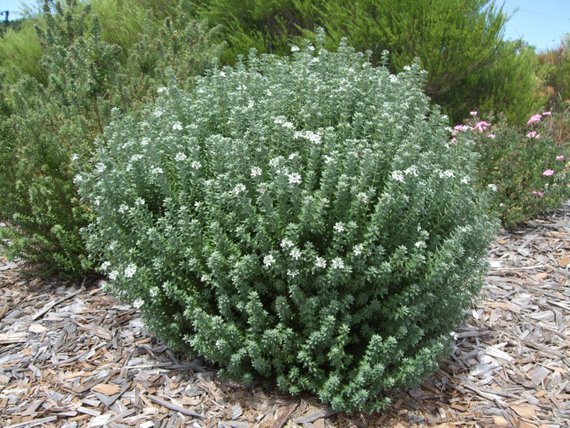
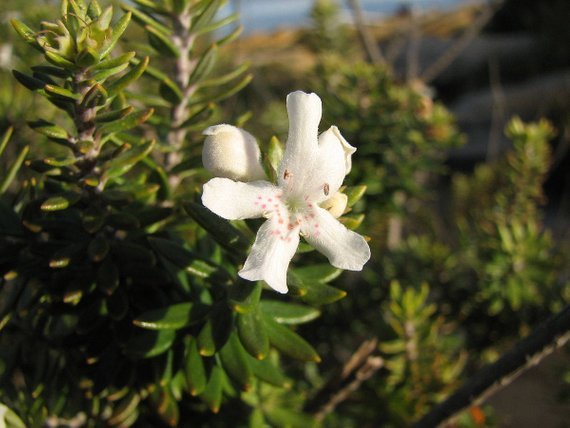
and decorate the garden with interesting compasses. Westing is a genus of evergreen shrubs that unite the family of labial flowers. In the genus there are about 25 varieties of erect evergreen and ornamental shrubs with a round crown. The leaves of the plant are densely, narrowed oval-linear, visually similar to the leaves of rosemary. The leaves are odorless and have a gray-green color. Growing whorls. The flowers are white, tubular, bilabiate. The upper lip is much longer than the lower one, the lower lip is divided into three broad lobes. Flowers are located at the ends of the stems in the axils of the upper leaves, flowers are single. The plant grows naturally into well-branched shrubs reaching a height of more than 1.5 meters.
The plant is distributed mainly in warm regions of Australia, where it grows along sandy beaches.
Westringia plant is decorative and often grown as a garden or indoor. Among the characteristics of care, the preference for growth is highlighted in a bright place, because the plant is light-loving and easily tolerated by heat.
https://www.etsy.com/au/listing/569054415/coastal-rosemary-aka-westringia
http://allflowerspot.ru/vestringiya.html
Westringia is a genus in the Mint Family with about 3 species, all endemic to Australia. Together with the closely related Prostanthera they are often called the Mint Bushes and many are used as ornamental plants in the garden. Westringia, which can be differentiated from Prostanthera by its leaves arranged in whorls and calyces with 5 distinct lobes while Prostanthera has a caylx with 2 lobes and leaves that are opposite. Westringia has a natural distribution throughout each state in Australia except the Northern Territories. .
They are generally tough plants and useful as large scale tall groundcovers, specimen plantings or for formal or informal screens. They have attractive whorls of small leaves that are usually a light gray-green color with some cultivars being attractively variegated. The flowers, which usually are most profuse from late winter to early summer color from white to light lavender though some can bloom year round in coastal climates.
They grow best in full sun but some can tolerate a varying amount of shade and while fairly drought tolerant most of the cultivated forms come from the more mesic climates of eastern and south eastern Australia and appreciate irrigation in summer
Source
Actually it's a beautiful plant with flowers! Bush type and pretty wonderful! According to your description this plant can survive under tough environmental conditions! It's really a great article and wish I could see this plant in my country! It seems suitable to my garden!@ctrl-alt-nwo,
Cheers~
westringia plants really very pretty plants in the world.but i am first time seen this plants flower in your blog.just fantastic creativity thought of you.its express your daily describing post quality.i am nature lover and i am growing alots of various plants in my garden. There are several varieties of Westringia,this flowers shapes and colour white and blue..its suitable to growing sunny weather.its rosemary plant but its botanical name westringria...this is a very mindblowing flower.you capturing very wonderfull flower to amazing plant flower.thanks to sharing for your great extraordinary post.very well done.take care yourself and best of luck of your great work..i wish that when i am seen this plant my country i am of course this plant growing to doing in my own garden..i pray to god your success in the bright future.may god bless you. my dear friend....@ctrl-alt-nwo really you are a big master nature beauty main part of flower..just marvelous..
Ozbreed Aussie Box® Westringia ‘WES08’ PBR
Great native alternative to exotic box plants

Requires less pruning than other Westringias
Drought tolerant and needs less water than exotic box plants
Description: Ozbreed Aussie Box® Westringia can be pruned into a box hedge or left in its natural ball shape whilst staying compact and tidy. Produces mauve flowers throughout spring/summer and has a dense growth habit. Great alternative to exotic box plants as it has faster establishment and requires less water and needs less pruning than other Westringias.
Size: 40-60cm high x 40-60cm wide pruned; 70-95cm high x 70-95cm wide unpruned. NOTE: in QLD and Northern NSW it can grow up to 50% larger in good free draining soils, pruning is recommended in these areas.
Uses: Hedges, borders, containers and mass plantings.
Position: Full sun to light shade. Suits most soil types, prefers free draining soils. Avoid wet feet or depressed planting areas. Tolerates frost and drought.
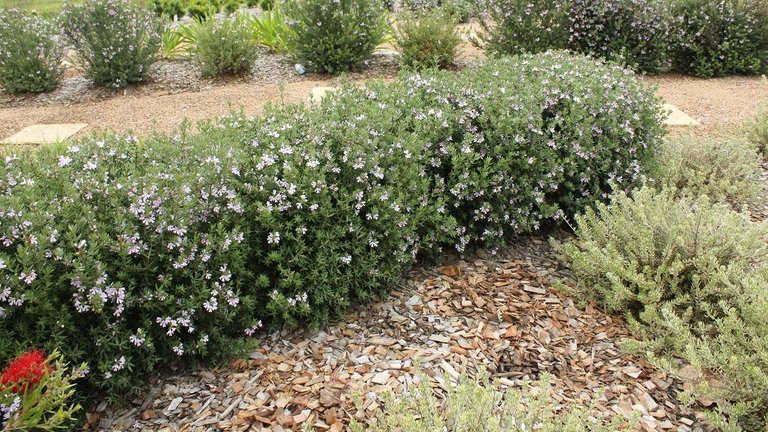
Care: Water as required for 8-13 weeks until established. Plant in a well mulched garden (chunky mulch is recommended). If required use slow release fertiliser in spring. Leave unpruned in its tidy natural shape or prune to shape 1-3 times a year after flowering (this depends on your requirements, more frequent pruning will provide a tidier shape).
Where it works: NSW, ACT, VIC, TAS, SA, WA and South East QLD (not suited to Northern QLD).
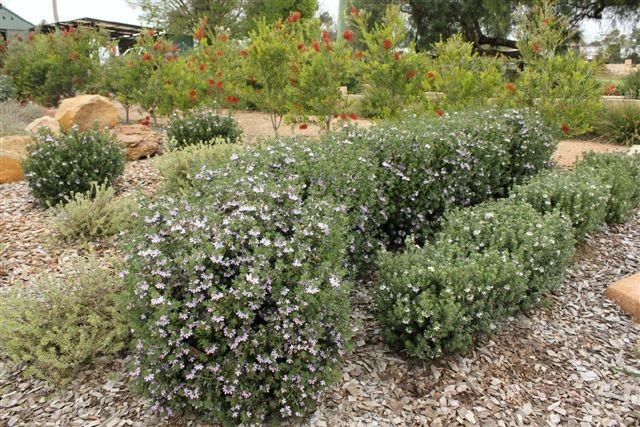 https://www.ozbreed.com.au/plant-ranges/native-shrubs-groundcovers/ozbreed-aussie-box-westringia-is-a-native-box-hedge-plant-with-mauve-flowers-and-a-dense-growth-habit-native-shrubs-ground-covers/
https://www.ozbreed.com.au/plant-ranges/native-shrubs-groundcovers/ozbreed-aussie-box-westringia-is-a-native-box-hedge-plant-with-mauve-flowers-and-a-dense-growth-habit-native-shrubs-ground-covers/
Thanks for you
Westringia is a member of the Lamiaceae family, making it a relative of Mint, Lavender and Salvia to name a few. A distinguishing feature of this family is the stems are squared off, almost like the result of fitting a square peg through a round hole. The 25 species are all native to Australia, occurring in all states except the Northern Territory. With the ability to be used in rockeries, cottage, native or coastal gardens, members of the Westringia species sit comfortably in many different styles of garden. There are also many smaller cultivars perfectly suited to smaller urban blocks.
These plants are drought tolerant, though providing the plant with some additional water during extended dry periods will prevent the leaves from yellowing and dropping. If this does occur, prune back to just below the remaining leaves soon after an adequate rain fall to help the plant regain a bushy habit.
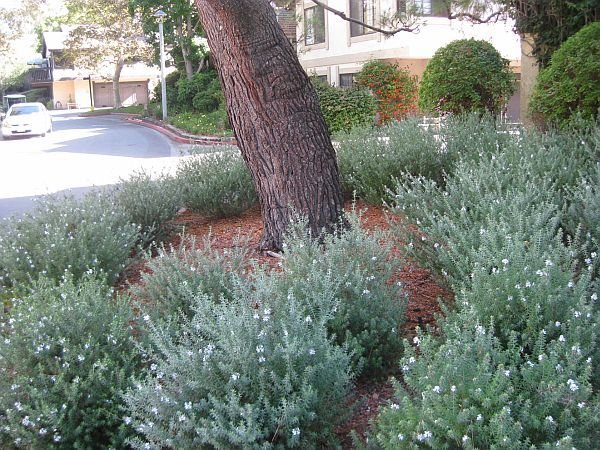
Westringia have a classic flower of the mint Family (Lamiaceae) with two upper lobes and three lower lobes. Colours range from white through pink to pale purple. Many species flower for most of the year, except in extreme hot and cold weather. During long periods of rain the flowers will rot, but the plant will throw out new blooms almost as soon as the sun reappears.
Cuttings can be used as a filler in flower arrangements with the stiff stems and attractive small leaves providing good visual structure. The buds will continue to open after being picked.
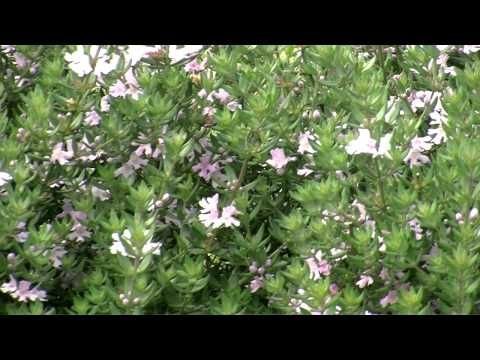
Preferably plant out in full sun. While they can handle light shade, the growth will be more open with fewer flowers. As they come predominantly from coastal regions, they prefer sandy soils. However they adapt well to any drained soil. Organic matter added to the soil will benefit the plant by maintaining a steady supply of moisture around the roots.
Westringia can also withstand sea spray.
Rarely are these plants affected by pests or diseases. The biggest threat to the health of the plant is heavy and poorly drained soil. The root system will rot very quickly if the plant finds itself sitting in constantly wet soil.
Westringia fruiticosa, otherwise known as Coastal Rosemary, is the most common species found in cultivation. In its original form, It will grow to 2m high and over 2 m wide. The leaves, which do resemble Rosemary, are grey/green on the upper side and silvery on the underside. They do not contain volatile oils to the same extent as Rosemary officionalis and have no culinary value. If left to its own devices in the garden, Coastal Rosemary will grow into quite an open shrub, with branches dropping towards the ground in a haphazard manner. This is a fantastic feature if you are trying to achieve a dune or heath land feel to the garden. Otherwise it responds well to regular, light prunings to forming it into a low hedge or neatly shaped shrub. Many cultivars of W. fruticosa exist including 50cm high ground covers and variegated forms such as ‘Smokie’.
It is maybe the cousin of the culinary herb type of rosemary but the leaves of this plant us wider. @ctrl-alt-nwo
It's not related to the culinary Rosemary, but the flowers and foliage a rather similar :)
Plants of the Westringia variety are another highly versatile Australian native that suits a wide variety of uses ranging from expansive groundcover, to colourful formal hedges, box gardens, retaining walls or as an ornamental shrub.
The popular Westringia owes its common names, ‘native rosemary’ or ‘coastal rosemary’, more to the shape of its leaves than any distinctive aroma. The leaves are often covered with an attractive contrasting grey or white velvety sheen.
Westringias are part of the mint family (Lamiaceae) but neither the leaves nor the flowers have a strong aroma.
The name westringia is a reference to the 19th century Swedish lichen authority and royal physician, Johan Peter Westring.
Source
Very nice and easy to after plant! I like these pale colour flowers! Growing up to two meters is pretty tall!
They comes in other colours as well , judging from your comment section!
Yes, they have got some new hybrids with more colours.
Westringia fruticosa 'Morning Light' (Coast Rosemary) - A small compact shrub which grows to 3 to 4 feet tall by 4 to 5 feet wide. The tightly crowded linear leaves have a cream colored variegation along the margins. The flowering period for the species Westringia fruticosa can be year round in coastal gardens but this plant is a bit more shy to bloom and flowers are typically only seen in spring – a good thing as the showiest aspect of this plant is the clean variegated foliage.
source
The small white flowers are the same as those of Westringia fruticosa. Plant in full sun or in bright filtered light. Will tolerate moderately dry growing conditions but looks best with some late spring and summer irrigation and can also be used in well-drained moist soils. Hardy to about 20° F – we lost our first garden planting of this cultivar in the disastrous freeze of December 1990, when we experienced several nights at or below 20° F. The species is native to the coast of New South Wales where it can be seen hugging the cliffs and growing near the sand on the beach.
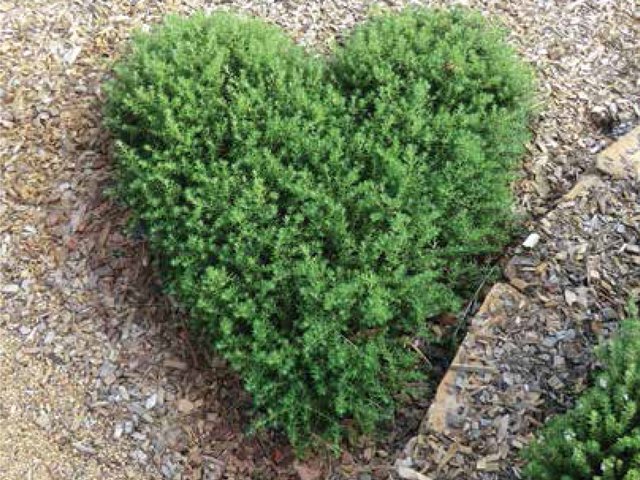
source
The name for the genus was given to it by Sir James Edward Smith, an English botanist and founder of the Linnaean Society in 1788. The name honors Dr. Johan Peter Westring (1753-1833), a botanist and physician to King Charles XIII of Sweden who was a student of Linnaeus. The specific epithet comes from the Latin word 'frutico' meaning "to put forth shoots" or "become bushy", likely in reference to the dense bushiness of this species. This origins of this cultivar are not known but it was noted in 1981 as growing in a nursery in Canberra, Australia. We received our plants from Kathy Musial at the Huntington Botanic Garden and have been growing it since 1990. We also grow the species Westringia fruticosa and another variegated cultivar Westringia fruticosa 'Smokey' and the low growing Westringia fruticosa Mundi as well as the hybrids Westringia 'Wynyabbie Gem', Westringia 'Wynyabbie Highlight' and Westringia Blue Gem.
source
This description is based on our research and observations made of this plant as it grows in our nursery, in the nursery garden and in other gardens that we have visited. We also try to incorporate comments received from others and appreciate getting feedback of any kind from those who have additional information about this plant, particularly if they disagree with what we have written or if they have additional cultural tips that would aid others in growing Westringia fruticosa 'Morning Light'.
A tough, small growing Australian native shrub with a compact, dense growth habit, introduced as an alternative to English and Japanese Buxus. Leaves are attractive, small, pale green maturing to emerald green, growing in whorls around the stems. Pretty, pale mauve flowers appear during Spring and Autumn. Grows in full sun to part shade, developing a tighter habit in full sun. Tolerates a wide range of soils and conditions, growing in sandy loams to clay loams. Withstands drought once established as well as heat, humidity, frost and salt spray. Best suited to arid Mediterranean climates. Clip every 12-18 months to form a tight hedge or leave to grow naturally to form a neat, ball-shaped plant. Perfect in low maintenance mass plantings, borders/hedges, coastal sites and water-wise gardens.
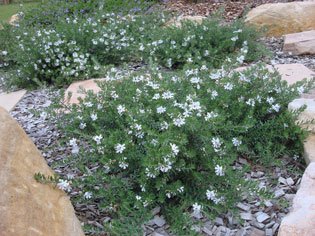

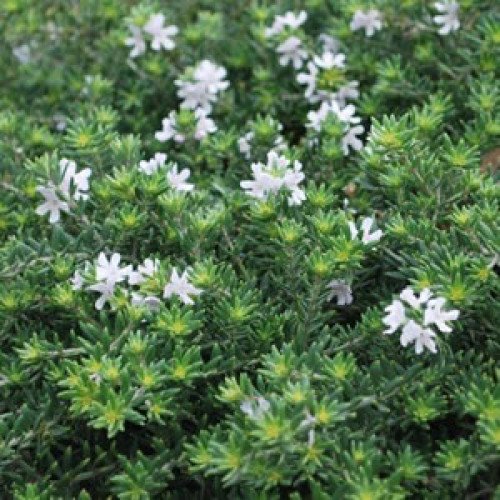 https://www.alpinenurseries.com.au/plant-library/westringia-fruticosa-aussie-box-pbr/
https://www.alpinenurseries.com.au/plant-library/westringia-fruticosa-aussie-box-pbr/
A tough, small growing Australian native shrub with a compact, dense growth habit, introduced as an alternative to English and Japanese Buxus. Leaves are attractive, small, pale green maturing to emerald green, growing in whorls around the stems. Pretty, pale mauve flowers appear during Spring and Autumn. Grows in full sun to part shade, developing a tighter habit in full sun.
Tolerates a wide range of soils and conditions, growing in sandy loams to clay loams. Withstands drought once established as well as heat, humidity, frost and salt spray. Best suited to arid Mediterranean climates. Clip every 12-18 months to form a tight hedge or leave to grow naturally to form a neat, ball-shaped plant. Perfect in low maintenance mass plantings, borders/hedges, coastal sites and water-wise gardens.
First time i know about this beautiful Australian plant. Really it's looking amazing.
image source
image source
Hope next time you will share more beautiful plants because we learn a lot from yours. Have a nice day sir @ctrl-alt-nwo.
Looks like good hedge material. :-)
It sure is a soldier type Plant given by the words of yours :)
While it sure is beautiful as well No wonder it is attractive and the color combination of white and blue looks really amazing :)
They for special shape looks beautiful thanks for sharing amazing plants everytime :D
Westringia is a genus of Australian shrubs. As with other members of the mint family their upper petal is divided into two lobes. There are four stamens - the upper two are fertile while the lower two are reduced to staminodes.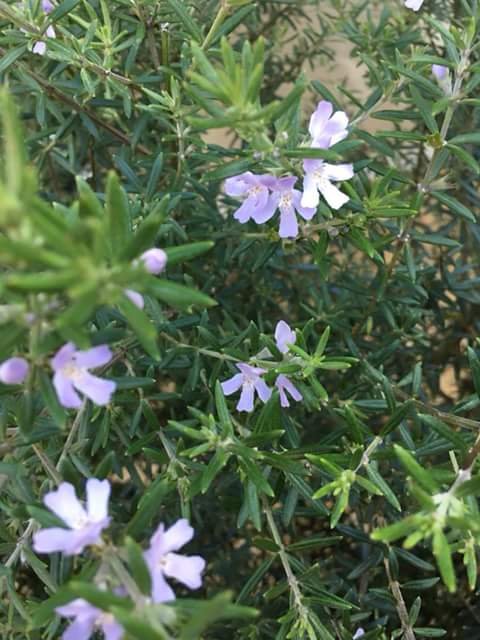
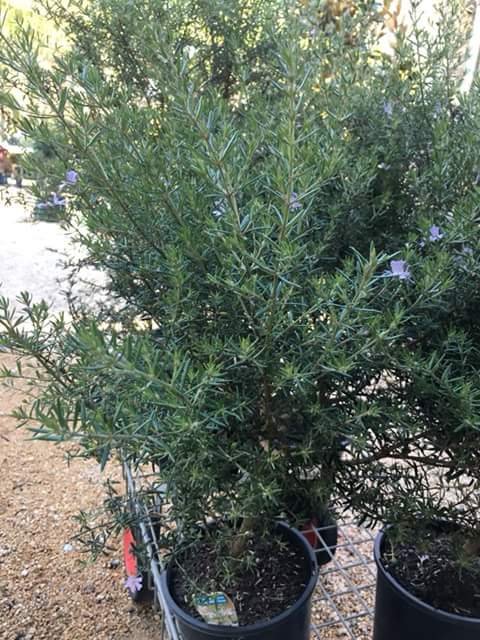 Blue Gem is an improved seedling selection of the Australian-native “coastal rosemary” that was selected for one simple reason: it’s flowers. In late winter/ early spring, Blue Gem will be completely covered with vivid…almost fluorescent flowers. Coastal rosemary, so named for its rosemary-like leaves, is drought tolerant, salt tolerant, has some frost tolerance and some varieties, including Blue Gem, are proving to be adapt to humid, subtropical climates of the southeastern US. Good for home gardens and commercial landscapes alike. Westringia are best suited to Mediterranean climates but, as mentioned, Blue Gem is showing promise for the South.
Blue Gem is an improved seedling selection of the Australian-native “coastal rosemary” that was selected for one simple reason: it’s flowers. In late winter/ early spring, Blue Gem will be completely covered with vivid…almost fluorescent flowers. Coastal rosemary, so named for its rosemary-like leaves, is drought tolerant, salt tolerant, has some frost tolerance and some varieties, including Blue Gem, are proving to be adapt to humid, subtropical climates of the southeastern US. Good for home gardens and commercial landscapes alike. Westringia are best suited to Mediterranean climates but, as mentioned, Blue Gem is showing promise for the South.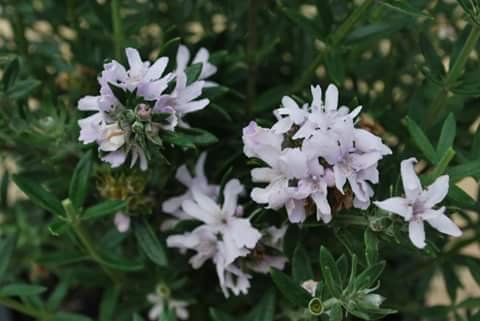
The flowers are white, hairy and have the upper petal divided into two lobes. They also have orange-to-purply spots on their bottom half. This shrub is very tough and grows on cliffs right next to the ocean.
The plant's tolerance to a variety of soils, the neatly whorled leaves and all-year flowering make it very popular in cultivation.
Sourse-:http://tuffyplants.com/westringia-blue-gem/
Westringia is probably the most common native used for hedging in Australia. Of those on our list of Not So Common hedge plants, Westringia and Pittosporum are the two most common. When allowed to grow naturally into a tight bun shape, Westringia looks fantastic as a low, curvy rather than square hedge. The grey-green foliage is a feature of this plant which continues to grow in popularity.
The blooms aren’t spectacular but aren’t to be sneezed at either. The worst problem you could have is gaps or, somewhat worse, a hedge that looks very bare because it’s been squared off rather than kept in the more circular bun shape.
Souce
Plants of the Westringia variety are another highly versatile Australian native that suits a wide variety of uses ranging from expansive groundcover, to colourful formal hedges, box gardens, retaining walls or as an ornamental shrub. Westringia will retain a healthy bushy appearance for many years without developing the woody appearance that spoils some groundcover plants.
image source
image source
image source
The westringia varieties feature dense, fast-growing foliage with delicate mauve, blue-purple or white flowers with contrasting red or brown spots near the throat of each flower. The grey to deep green leaves form attractive whorls around the stem. Westringia usually flower prolifically, often throughout the year, and also respond well to pruning. The popular Westringia owes its common names, ‘native rosemary’ or ‘coastal rosemary’, more to the shape of its leaves than any distinctive aroma. The leaves are often covered with an attractive contrasting grey or white velvety sheen.
Westringias are part of the mint family (Lamiaceae) but neither the leaves nor the flowers have a strong aroma. The name westringia is a reference to the 19th century Swedish lichen authority and royal physician, Johan Peter Westring.
information source
I love flowers and various beautiful plants. So always being curious to know about new plants or flowers. Westringia is also a beautiful native Australuan plant.
photo source
Westringia is a small white flowers bloom along the branches year-round in mild climates but it is a spring-bloomer in colder areas. Plant in full sun where it is drought tolerant but keeps better color and remains more dense when given occasional spring and summer irrigation.
photo source
Thanks a lot sir @ctrl-alt-nwo for eveyday sharing some new plants and flowers.
Westringia is a very beautiful Australian plant. Everyday from your blog i can learn about many new plants botanical name. And today i learn about Westringia.
image source
image source
The flowers are white, hairy and have the upper petal divided into two lobes. They also have orange-to-purply spots on their bottom half. This shrub is very tough and grows on cliffs right next to the ocean.
The plant's tolerance to a variety of soils, the neatly whorled leaves and all-year flowering make it very popular in cultivation.
source: https://en.m.wikipedia.org/wiki/Westringia_fruticosa
As a large permanent feature in a garden or public grounds where space is available, the Coastal or Native Rosemary (Westringia fruticosa) is an excellent choice. It is an easily grown shrub of simple and neat appearance which grows wild near the coast of New South Wales. Stretches of it are seen hugging the cliffs and down to beach level, either prostrate or several feet high depending on situation.
White flowers dot the shapely plants. Growth is naturally stiff and bushy but responds to garden treatment by growing much taller. lt reaches at least 2 m high and 5 m across, often forming a regular dome with its lower branches covering the ground. lt is useful as a large type of ground-cover plant. Sometimes it throws out one or two main branches to develop an irregular habit, but generally the plant is shapely. After reaching a mature size it does not deteriorate quickly with age as some species do, but maintains a good condition for years. During the coldest weather it keeps a fresh appearance and is also drought hardy, though adequate water should be given to avoid tendency to yellowing leaves and bare wood.
https://www.anbg.gov.au/gnp/gnp1/westringia-fruticosa.html
Great photos, @ ctrl-alt-nwo
I've never even heard of a Westringia plant before.
Thank you for showing me and telling me what it looks like.
We probably don't grow them.
Thanks for the new knowledge.
source
Happy to introduce something new !
Westringia 'Smokey' in the garden.
Westringia is a genus in the Mint Family with about 3 species, all endemic to Australia. Together with the closely related Prostanthera they are often called the Mint Bushes and many are used as ornamental plants in the garden. Westringia, which can be differentiated from Prostanthera by its leaves arranged in whorls and calyces with 5 distinct lobes while Prostanthera has a caylx with 2 lobes and leaves that are opposite. Westringia has a natural distribution throughout each state in Australia except the Northern Territories. They are generally tough plants and useful as large scale tall groundcovers, specimen plantings or for formal or informal screens. They have attractive whorls of small leaves that are usually a light gray-green color with some cultivars being attractively variegated. The flowers, which usually are most profuse from late winter to early summer color from white to light lavender though some can bloom year round in coastal climates. They grow best in full sun but some can tolerate a varying amount of shade and while fairly drought tolerant most of the cultivated forms come from the more mesic climates of eastern and south eastern Australia and appreciate irrigation in summer.
We grow or have grown the following Westringia at San Marcos Growers
Westringia Blue Gem ['WES03'] PPAF (Blue Gem Coast Rosemary) - A beautiful newer selection of the Australian Coast Rosemary shrub that has a compact upright form to 3 to 5 feet tall by 3 to 4 feet wide with foliage composed of narrow 3/4 inch long olive-green leaves on dark maroon-brown stems. The vibrant bluish purple flowers erupt in profusion in spring but are also present throughout much of the rest of the year. Plant in full sun to light shade and irrigate infrequently to occasionally. Like other Westringia cultivars this plant is tolerant of most soils so long as they drain and situations including coastal exposure, drought, inland heat and humidity. Hardy to at least 25° F and likely a bit lower - possibly to as low as 18° F for short durations. Prune to shape once or twice a year to keep it dense and it can be kept as a smaller shrub and with more regular trimming it makes an excellent compact low hedge to around 3 feet tall - tolerates this pruning treatment far better than the similar and larger cultivar 'Wynyabbie Gem'. With its long blooming period this plant also will make a great landscape specimen in the garden. This plant comes from the controlled breeding work conducted by University of Sydney's Plant Breeding Institute in October 2005. Under the cultivar name 'WES03' it received Plant Breeder's Rights in Australia in May 2013 held by NuFlora International Pty Ltd.
Westringia brevifolia - Small-leafed Westringia - An upright growing dense shrub 5-6 ft tall by 2-3 feet wide with gray-green 3/4 inch long narrow leaves whorled in sets of fours around slightly hairy branches. The large wide open flowers are a very pale violet to white. Very tolerant of diverse conditions from sandy to clay soils, wet or dry in sun or shade. This plant grew originally where the city of Hobart, Australia now stands. We grew this plant from 2002-2004 but no longer offer it
Thank you for telling me about this wonderful plant. I especially liked the first photo.
These little delicate beauties are not known to me. All the more, I am pleased to read information about this unique plant.
Greetings and have a full of flowers day :)
Thank you for another plant not known to me :). Westring shrub
In the genus of 25 species of upright evergreen shrubs with a rounded crown. They grow on sandy beaches in warm regions of Australia. Leaves are densely located narrowed, linear, oval, similar to rosemary, grow whorled by 3-5. Good looking at the garden areas.
https://otvet.mail.ru/question/194780161
All of these Westringias are bread in Australia from originally native plants and are tough, drought resistant and tolerant of cold conditions. They will grow in light shade to full sun, coastal positions and in virtually any reasonably well drained soil.
Requiring virtually no care requirements, they have the added bonus of flowering against their appealing foliage. A little trimming to shape is recommended, although even left alone they remain compact and true to shape. Feed with a good quality slow release fertiliser in spring. These plants are a great alternative to Buxus and many other choices, establishing quickly and suffering virtually no disease or problems often associated with difficult locations.
image source
They make stunning layered hedges and look great planted in any combination together, either randomly or in formal hedge style plantings.
Content source